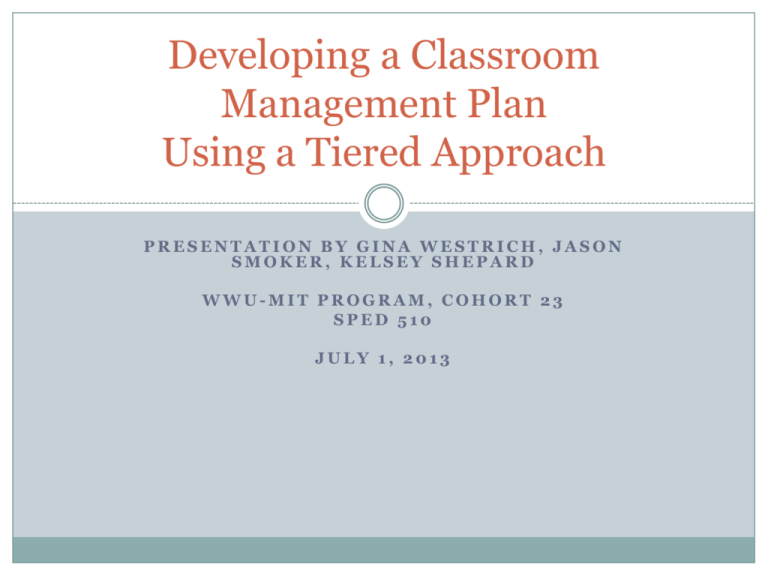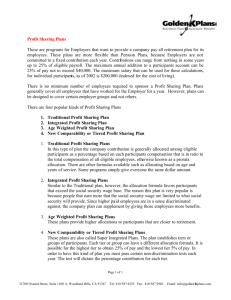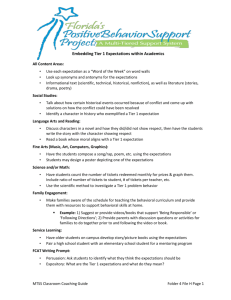File - Mrs. Westrich's Class Website
advertisement

Developing a Classroom Management Plan Using a Tiered Approach PRESENTATION BY GINA WESTRICH, JASON SMOKER, KELSEY SHEPARD WWU-MIT PROGRAM, COHORT 23 SPED 510 JULY 1, 2013 About the Authors Kristin L. Sayeski Assistant Professor at UNLV (at time of publication); now at University of Georgia Department of Communication Disorders and Special Education Research interests: Inclusion, learning disorders (LDs), spelling for students with LDs, Math & Special Education, Special educators’ tools and collaboration About the Authors, continued. Monica R. Brown, PhD Associate professor at New Mexico State University. Department of Special Education/Communication Disorders Doctorate at UNLV Won 2010 Roush award for NMSU teaching excellence Research interests: disaffected adolescents, multicultural special education, technology access and use, and secondary education. Journal Information Article was from the Journal: TEACHING Exceptional Children. Published in Sept/Oct 2011; thus still relevant information Journal written for: teachers, administrators, paraprofessionals, practitioners who work with children & youth with disabilities or who are gifted. Purpose of Publication advance the professional development of practitioners to provide useful information, resources, tools for improving education & services for exceptional learners. articles share innovative and successful methods and materials based on current evidence-based practice Audience Educators, Special and General “In this article, we present a response-to-intervention (RTI) framework that both special and general education teachers can use in evaluating existing class structures and developing comprehensive classroom management plans for the purpose of managing challenging behaviors” (p. 8) For any educator, but especially useful for anyone dealing with multiple consistent behavior issues and/or who have students with IEPs for emotional disturbance (Emotional or behavioral disorders) Sources Sayeski, K. L., & Brown, M. R. (2011). Creating a classroom management plan using a tiered approach. Teaching Exceptional Children, 44(1), 8-17. Sources for Author Information: Brown, M. (2007). Educating all students: Creating culturally responsive teachers, classrooms, and schools. Intervention in School and Clinic, 43(1), 57-62. Retrieved from http://csuprofessionaldevelopment.com/images/pdfs/Educatin gAllStudents.pdf University of Georgia Faculty Directory: http://www.coe.uga.edu/people/ Summary USE OF A RESPONSE TO INTERVENTION (RTI) FRAMEWORK o BOTH SPECIAL AND GENERAL EDUCATION EDUCATORS CAN USE o EVALUATE EXISTING CLASS STRUCTURE o DEVELOP COMPREHENSIVE CLASSROOM MANAGEMENT PLAN The more transparent and clear teachers are about their behavioral expectations, the more successful students are in meeting those expectations THREE TIERED APPROACH Tier 1 = prevention Tier 2 = first-line intervention Tier 3 = intensive, individualized TIER 1 (Prevention) High teacher expectation Stimulating instruction with high levels of student engagement Positive teacher-student rapport Efficient use of classroom time Clearly communicated rules and norms* Posted Student derived Established routines and norms* Submitting work Missed classes Cooperative learning groups TIER 2 (First-line) Surface management techniques Planned ignoring Signal interference Proximity Hypodermic affection Regrouping Antiseptic bouncing Reinforcement systems Consistent consequences to specific behaviors Token economies Behavior contracts Group contingencies TIER 3 (Individualized) Always begin with a Functional Behavioral Assessment (FBA) “why is the student behaving like this?” “what socially acceptable behavior can we teach to address this same need?” Intervention is specific for each individual Effective strategies for replacement behavior Social skills Self-monitoring without a solid ‘core’ of behavioral support in the classroom, students do not have the guideposts necessary to learn, practice, and develop desirable skills.” “ www.nuffieldhealth.com Reactions from the group Kelsey Shepard great system for creating a plan for behavior management. like the emphasis on teaching students your expectations and giving many opportunities for positive reinforcement I have seen the "token system" used with students who have an Autism diagnosis and for some it was very effective. I could definitely see myself using this method in my classroom Jason Smoker managing behaviors is a function of the structure that one sets forth in their classroom. students should have a clear picture of what is expected of them and what they need to succeed we are guides and facilitators that must avoid disciplining students simply from force of will or authority. Gina Westrich As a parent it makes sense that students need specific guidelines and boundaries Important to have ready at beginning of school year- modifications over the school year Implications for Educators Behavior management is a function of structure. Clear expectations for both work and social norms. “Research consistently demonstrates that students show a clear preference for strong teacher guidance over permissive classroom environments (Wubbels & Brekelmans, 2005).” (Sayeski & Brown, 2011) p.5. We must lay a solid groundwork first. “A high-quality core curriculum must be in place before examining student-specific concerns Without a solid "core" of behavioral support in the classroom, students do not have the guideposts necessary to learn, practice, and develop desirable skills (Sayeski & Brown).” p.9 Relevance to this class Our Response to Intervention should have multiple tiers “An RTI model provides a framework for teachers to evaluate classroom practices and make decisions about the level of intervention or support needed. (Sayeski % Brown)” p9. Tier 1 : Preventative Classroom Management. Tier 2: First-Line Interventions. Tier 3: Intensive, Individualized Interventions. This empowers the students to take control of their own learning opportunities Teaches skills that will go beyond each classroom. Provides guideline/support for allocating educational resources. Sustainable for both teacher and student.



